What are the four famous inkstones and Top Ten Inkstones: Types, Prices, Identification Methods, and Inkstone Care Tips
As someone who previously shared articles about Chinese calligraphy brushes, Xuan paper, and ink, I wanted to complete my series on the “Four Treasures of the Study” by covering inkstones. While I personally use ordinary inkstones, this knowledge may be useful for future reference. I hope you find it helpful!
China’s Top 10 Inkstones – Types of Inkstones
When we mention the “Four Treasures of the Study,” we immediately think of “brush, ink, paper, and inkstone.” Although the inkstone comes last in this list, this doesn’t diminish its importance in calligraphy and collecting circles.
Inkstones are essential tools for Chinese brush calligraphy. Due to their durability, they can last for centuries without deterioration and have been treasured by scholars throughout history. Inkstone materials include not only Duan stone, She stone, Tao River stone, Chengni stone, Red Silk stone, Tuoji stone, and Chrysanthemum stone, but also jade inkstones, mixed jade stone inkstones, tile inkstones, lacquer-sand inkstones, iron inkstones, bronze inkstones, porcelain inkstones, and dozens of other varieties.
Many regions in China produce stone inkstones. Since the Tang Dynasty, four have been recognized as the “Four Famous Inkstones“: Duan inkstones from Duanxi in Guangdong, She inkstones from She County in Anhui, Tao inkstones from southern Gansu, and Chengni inkstones from Luoyang in Henan. However, the calligraphy community recognizes ten major inkstones:
1. Guangdong Duan Inkstone
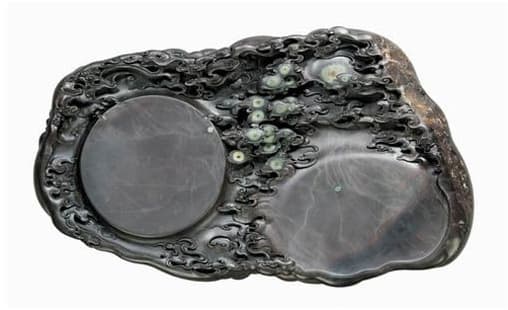
Made from Duanxi stone, these inkstones come from Duanxi in the eastern suburbs of Zhaoqing City, Guangdong Province.
Duan inkstones feature fine, tender stone texture that produces ink without damaging brush bristles. You can even make ink by breathing on them. The natural patterns in the stone create different “stone grades,” such as Banana Leaf White, Fish Brain Jelly, Sky Blue, Fire Marks, Pig Liver Jelly, Gold Star Points, Ice Pattern, and Stone Eyes.
The craftsmanship of Duan inkstones is extremely refined, known for their classical elegance, simplicity, and natural beauty. They are recognized as “first among inkstones,” “the world’s finest inkstone,” and “the treasure among the Four Treasures.” Since their emergence in the Tang Dynasty, scholars have favored them for being “heavy yet light, hard yet soft, smooth with no harsh sound when touched.”
2. Jiangxi She Inkstone
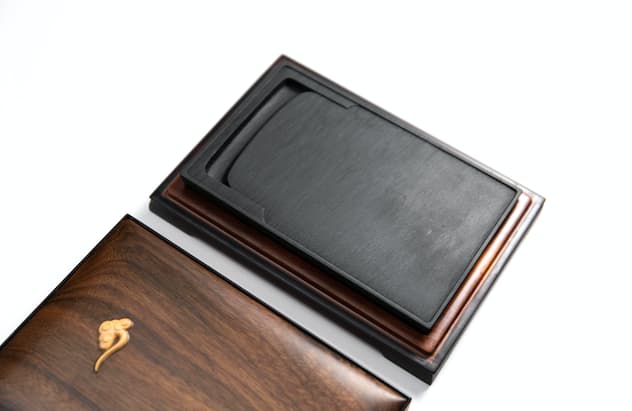
Originating in the Tang Dynasty, these come from ancient Shexian (now Wuyuan in Jiangxi, and Shexian, Yixian, and Xiuning in Anhui). The best quality comes from Longwei in Wuyuan, so they’re also called Longwei inkstones.
She inkstones have a tough, moist, and dense texture with beautiful patterns. They feel like skin to the touch, develop an edge when ground, hold water for the brush while releasing ink smoothly, dry quickly, and clean easily. When tapped, they produce a clear metallic sound. They retain water without evaporation, don’t freeze in cold temperatures, can produce ink with just breath, and don’t damage brush bristles. Since the Tang Dynasty, they have maintained their reputation as famous inkstones.
3. Shanxi Tao Inkstone
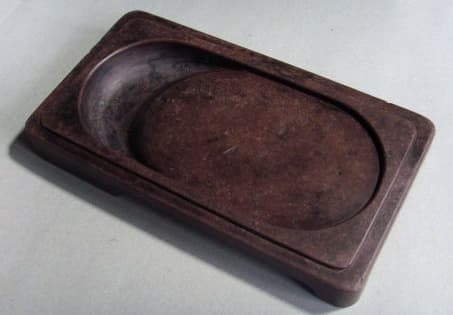
Shanxi Chengni inkstones from Xinjiang County (formerly Jiangzhou) in Shanxi Province are among China’s four famous inkstones, alongside Duan, She, and Tao inkstones. They come in different colors depending on raw materials and firing time. The best colors are cinnabar red, eel yellow, crab shell green, bean green sand, and sandalwood purple, with cinnabar red and eel yellow being the most precious.
Chengni inkstones don’t use colored glaze. Instead, they use scientific formulations, careful herbal fumigation, and special kiln firing to create natural color variations – each inkstone from the same kiln has unique, magical coloring.
Made from finely washed clay, Chengni inkstones have a texture as delicate as a baby’s skin. They store water without drying up, don’t freeze in cold, produce ink without damaging brush bristles, and stay more moist than water. They’re hard-wearing, jade-like in appearance, can produce ink with just breath, and don’t damage brush bristles. Though created in the Tang Dynasty and favored by emperors and scholars, the craft was unfortunately lost during the Qing Dynasty. In 2025, I saw some Chengni inkstone booths at a Four Treasures exhibition, though I’m unsure if they use traditional techniques.
4. Gansu Tao Inkstone
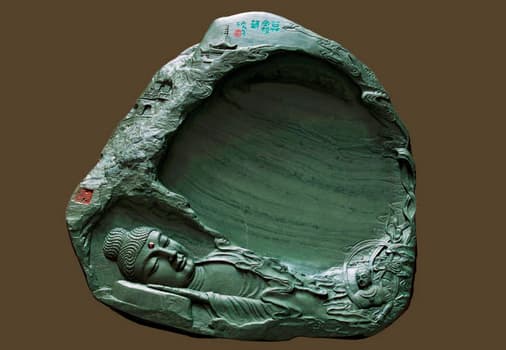
Also called Tao River stone inkstones, these are sourced from deep water areas of the Tao River in Zhuoni, Gansu. The Tao River originates from ancient Taozhou, hence the name.
Tao inkstones have a smooth, fine texture with beautiful coloring. They produce ink quickly and store it for long periods. Tao River stone comes in two varieties: green and red. The green type includes “duck head green” and “parrot green” stones with silk-like patterns that are clear and attractive. The red type has a pure earth-red color that is rare and finely textured. Few Tao River stone inkstones survive today.
5. Shandong Lu Inkstone
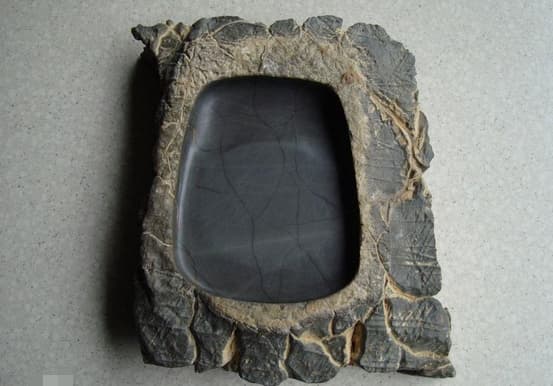
Made from various stones produced in Shandong Province, the Red Silk stone inkstone represents Lu inkstones, famous for their tender texture, brush protection, ink production, and gorgeous colors. Lu inkstones have distinctive qualities in texture, color, pattern, and natural shape, including Red Silk stone, Zi stone, Nishan stone, Xu Gong stone, Fulai stone, and more than ten other varieties. These materials are all deeply penetrating and tender, firm but not stubborn, smooth but not slippery, and produce ink without damaging brush bristles.
Additionally, the Zichuan and Boshan areas of Zibo City in Shandong Province produce Zi stone inkstones, also called Golden Star inkstones, with a thousand-year history. Zi stone comes in green, yellow, purple, and dozens of other varieties. Green types include lotus leaf green, bamboo green, lettuce green, and deep green; purple includes mountain red, purple cloud, and dark red; yellow includes dark yellow, tangerine yellow, and bundle yellow. Other varieties include ochre, multicolored, and dark blue. Pearl spots, emerald spots, ice patterns, gold and silver stars, and color halos often appear on the surface of Zi stone inkstones.
6. Sichuan Zuoque Inkstone
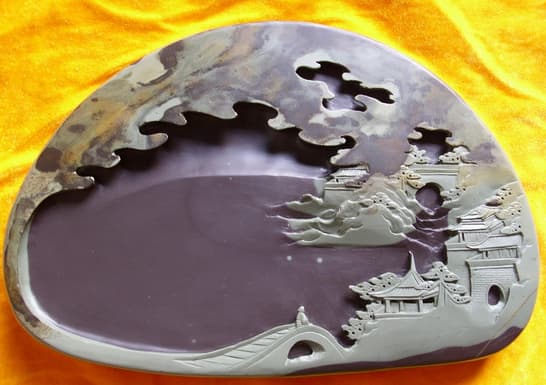
These inkstones come from the cliff faces in Pingdi Town and Dalontan Township of Renhe District, Panzhihua City, Sichuan Province. This area was anciently called “Zuoque,” hence the name.
Zuoque inkstones combine shallow relief, openwork, round carving, deep carving, thin carving, and reduced ground carving techniques, creating a heavy, bright, and rich multi-dimensional style. They feature nearly a hundred gorgeous stone varieties, including stone eyes, blue flowers, gold stars, ice patterns, green flesh, yellow flesh, fire marks, eyebrows, gold lines, fish brain jelly, banana leaf white, temple front green, jade belt, purple sand, chicken blood, and more. Of these, the jade-like, pearl-like stone eyes are especially famous.
Zuoque inkstones are colorfully diverse and naturally beautiful. The extremely crystalline “Golden Field Yellow” has a golden-green luster; “Sealed Snow Red” has a white exterior like clear snow and an interior red as cinnabar; “Cyan Cloud Jelly” is tender and pleasing like congealed cream; and “Green Vine Jade” has a natural charm like jade in a valley. Zuoque inkstone’s texture is fine, produces ink like oil, preserves ink without spoiling, wears well while protecting brush bristles, can produce ink with breath, rings like metal or jade when tapped, and feels as delicate as a baby’s skin when touched.
7. Ningxia Helan Inkstone

Sourced from Bracks Mountain at the foot of the Helan Mountains in Ningxia Hui Autonomous Region.
Helan inkstones come in deep purple and light green natural colors, with purple being the main color for inkstone-making and green used as highlights. Stones with eyes, jade belts, silver coins, eyebrows, and cloud patterns are especially valuable. These inkstones have a fine texture, produce fine ink, don’t leak or seep, don’t dry or smell, and don’t damage brush bristles.
8. Guizhou Sizhou Stone Inkstone
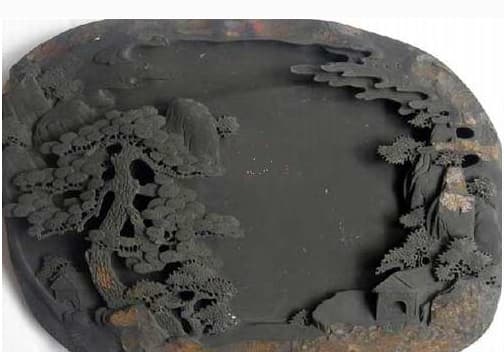
The stone comes from Xingtai Pool in Cengong County, Guizhou Province. These inkstones are firm and smooth, produce fine ink, don’t hinder the brush, and store ink for all-day use. Even without water, breathing on the inkstone produces moisture for writing. The stone quality is firm and smooth like jade, ink-colored, with the advantages of “special quality of water and stone, unrefined gold and jade, cloud-producing moisture, and care for ink and brush.”
Sizhou stone inkstones are primarily made using relief carving with an ancient and heavy style.
9. Jilin Songhua Imperial Inkstone
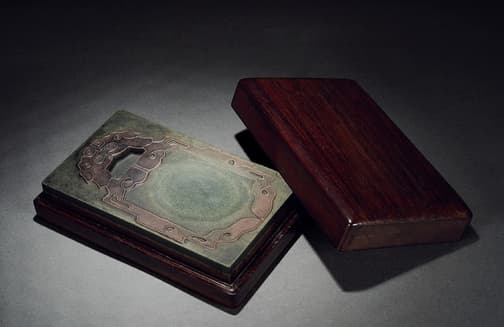
Produced in the Changbai Mountain area of Northeast China, these come in four colors: purple-red, purple-green mixed, deep green, and light green, sometimes with yellow and brush-stroke patterns. Deep green with brush strokes is considered the highest quality.
Songhua Imperial inkstones have a solid texture that produces ink well. Their hardness exceeds both Duan and She stones, and after grinding, water washing leaves no traces.
10. Hebei Yishui Ancient Inkstone
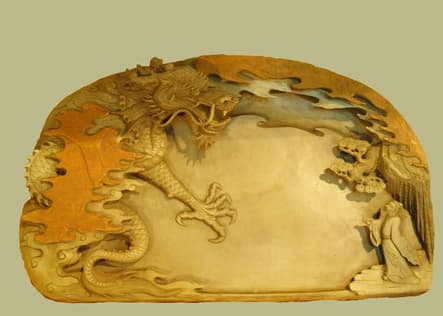
A traditional famous inkstone from Hebei, produced in Yizhou (now Yi County) and also called Yi inkstone. The stone is taken from Zhongnan Mountain in Yi County, Hebei Province. The inkstone has soft colors of purple metamorphic rock, often decorated with cyan, light yellow, or gray spots.
Yishui inkstones have a fine, smooth texture that is both hard and soft, easily produces ink, stores ink for long periods, and doesn’t hinder ink flow. Their carvings are famous for turtle, dragon, zither, beast, and chess designs.
Inkstone Prices
Student inkstones typically cost from a few yuan to several dozen yuan online. For beginners in calligraphy, I recommend ordinary inkstones costing several dozen yuan, available from online stores selling Four Treasures or stationery. Gift or collection-quality inkstones are more expensive, ranging from several hundred to several thousand or even tens of thousands of yuan online.
Selecting and Authenticating Inkstones
Whether for personal use, collection, or gifting, knowing how to identify a good inkstone is important. Here are some helpful tips:
- “Examine the material” – Look at the inkstone’s material, condition, craftsmanship, and inscriptions.
- “Feel its body” – A good inkstone feels smooth and fine when touched, like a child’s skin. Good inkstones also feel cool to the touch.
- “Test its weight” – Weigh the inkstone in your hand; between two inkstones of the same size, the heavier one is better.
- “Listen to its sound” – Hold the inkstone with five fingers and gently tap or flick it. She inkstones should produce a crisp metallic “tang-tang-tang” sound, while Duan inkstones should sound like bamboo or wood. If a Duan inkstone produces a metallic sound, it’s lower quality.
- “Clean off the ink” – This means removing grinding marks to restore the inkstone’s original appearance, making it easier to see any damage or repair marks.
Caring for Inkstones
Some say inkstones are “nurtured.” A good inkstone indeed requires careful attention.
First, avoid direct sunlight, which can cause drying and cracking.
Also, avoid letting inkstones contact metal or glass objects, as these hard materials can easily scratch the stone.
Regular waxing is essential. When applying wax, some people coat the entire inkstone, others apply vegetable oil, and some apply ink, thinking this nurtures the stone. These methods aren’t appropriate. The correct method is to apply wax around the four sides of the inkstone, but never to the grinding surface.
Timely cleaning is important. According to “Ancient Inkstone Studies”: “It was said in the past: Better not to wash your face for three days than not to wash your inkstone for one day. Inkstones must be washed diligently. Frequent washing prevents drying and brings out their spirit. If not cleaned for three days, the old ink congeals, hindering writing and making the ink color dusty and unclear…” This means inkstones should be cleaned promptly, preferably with clean water (never hot water or tea water containing acids or alkalis) using a loofah or sponge brush.
When washing, be careful and gentle. A wooden basin is best; washing in cement or porcelain basins can damage the inkstone.
Ultimately, if we treat inkstones as living objects and care for them attentively, they will always maintain their vitality and life force. For more information on inkstone care, please refer to my previous articles.
Such as:

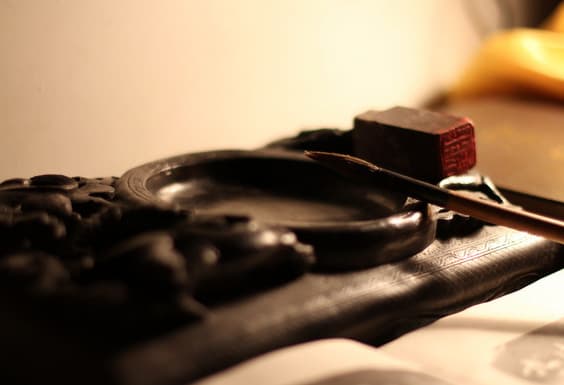
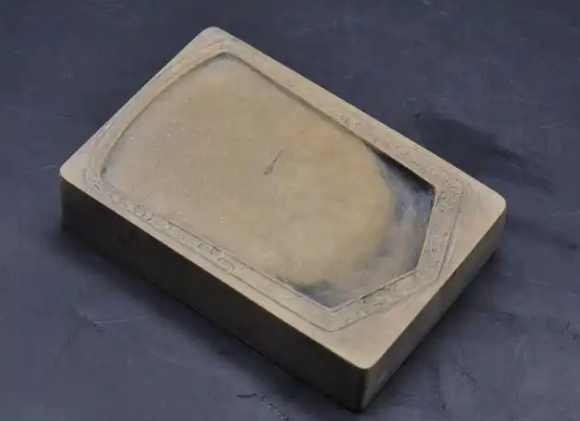
nice
thanks
Reading your piece felt like walking through a lush garden of ideas, each one blooming with vibrant insights that invited both contemplation and joy. Your words move with such effortless grace, and the way you bring together seemingly disparate thoughts into a cohesive whole is nothing short of magical. It’s a rare gift to make complex ideas feel so accessible, yet so profound.
Thank you, I’m glad to see you like Chinese calligraphy too!
This actually answered my downside, thank you!
Thank you for reading this article,I thought no one would read these articles I’m writing.
I think this site contains some rattling fantastic info for everyone :D. “Laughter is the sun that drives winter from the human face.” by Victor Hugo.
I really like this sentence you said. :D. “Laughter is the sun that drives winter from the human face.” by Victor Hugo.
Probably in 1992 or 1995 when I was in Hong Kong on holiday from Australia I went to a market street on the island and bought an inkstone. It is beautifully carved on both sides(top and bottom) . on one side it appears to have a bat or grasshopper emerging from behind a copper coloured leaf , covered with oriental writing (I don’t know whether Chinese or Japanese), and a gold dot 6mm across. On the other side the pattern of leaves continues with 3 gold dots with some more writing and what is probably a makers mark. The stone is about 18cm x 12 cm. I cleaned a bit of the black off to see if I could expose the writing and the background colour of the stone is a deep dark red.
Could I send you some photographs of this item , and could you perhaps tell me a little about it. I did not pay very much for it , but I treasure it greatly.
Thank you
Of course, thank you for trusting me. I’m not sure I can identify its material, but I would very much like to see the ink stone you mentioned. My email is lqkimilau@gmail.com.
Probably in 1992 or 1995 when I was in Hong Kong on holiday from Australia I went to a market street on the island and bought an inkstone. It is beautifully carved on both sides(top and bottom) . on one side it appears to have a bat or grasshopper emerging from behind a copper coloured leaf , covered with oriental writing (I don’t know whether Chinese or Japanese), and a gold dot 6mm across. On the other side the pattern of leaves continues with 3 gold dots with some more writing and what is probably a makers mark. The stone is about 18cm x 12 cm. I cleaned a bit of the black off to see if I could expose the writing and the background colour of the stone is a deep dark red.
Could I send you some photographs of this item , and could you perhaps tell me a little about it. I did not pay very much for it , but I treasure it greatly.
Thank you
Thank you for sharing your wonderful ink stone purchasing experience with me. Based on your description, it might be a Duan ink stone, but we would need further verification to determine the specific material. You’re welcome to send photos of the ink stone to my email at lqkimilau@gmail.com.
so much superb info on here, : D.
Thank you, this is exactly the goal I’m striving to achieve.
I like the valuable info you provide in your articles. I will bookmark your blog and check again here regularly. I’m quite sure I’ll learn lots of new stuff right here! Best of luck for the next!
This is my honor. It seems you are also a Chinese calligraphy enthusiast.
Good write-up, I am normal visitor of one’s site, maintain up the nice operate, and It is going to be a regular visitor for a long time.
Thank you. I will keep updating this blog with articles on Chinese calligraphy and traditional scholarly tools. Hope to see you back here frequently.